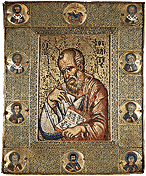 |
|
 |
Minor arts
 uxuriousness and a strong emphasis on the decorative aspect, are what
particularly characterise the creations of the minor arts in the
uxuriousness and a strong emphasis on the decorative aspect, are what
particularly characterise the creations of the minor arts in the
 13th century, while obvious, at the same time, is the artist's desire
to imitate earlier models. The conquest and sack of Constantinople during
the Fourth Crusade, resulted in a large part of the precious objects produced
in the earlier Byzantine period being lost forever or finding their way
into the treasuries of the West. The covetousness of the
Crusaders with regard to
the fabulous treasures of the largest and richest city of the then known
world has been vividly described in documents of the time, such as the
works of the historian
Niketas Choniates.
13th century, while obvious, at the same time, is the artist's desire
to imitate earlier models. The conquest and sack of Constantinople during
the Fourth Crusade, resulted in a large part of the precious objects produced
in the earlier Byzantine period being lost forever or finding their way
into the treasuries of the West. The covetousness of the
Crusaders with regard to
the fabulous treasures of the largest and richest city of the then known
world has been vividly described in documents of the time, such as the
works of the historian
Niketas Choniates.
The Crusaders, however, were not the only ones responsible for the destruction and disappearance of precious objects. In the following years, in times of hardship, silver works of art were melted down to make coins so as to meet extraordinary expenses.
Important works of the period are the silver revetments of icons. The detailed elaboration, splendid design, the highly decorative result obtained, are characteristic of the developments in the field of the minor arts. The chronological classification of these beautifully wrought covers poses a problem, as they were not necessarily made at the same time as the icon itself. Of course, some of them can be dated with certainty, thus providing a point of reference for the dating of the rest. An important example of this is the icon of the Virgin in the Tretyakov Gallery in Moscow, the donors of which were Constantine Akropolites - the
megas logothetes
of
Andronikos II, who
died before 1324 - and his wife Maria, who are depicted in the lower part of the silver cover. In other examples a still more luxurious result is achieved by the combination of other techniques. Such an example is the frame of the mosaic icon of St. John the Theologian from the monastery of the Great Lavra on Mount Athos, dating from around 1300, which is decorated with
enamel
medallions bearing representations of saints. These medallions, probably produced in the 12th century, are here re-used, a very common practice in the Byzantine world.
|